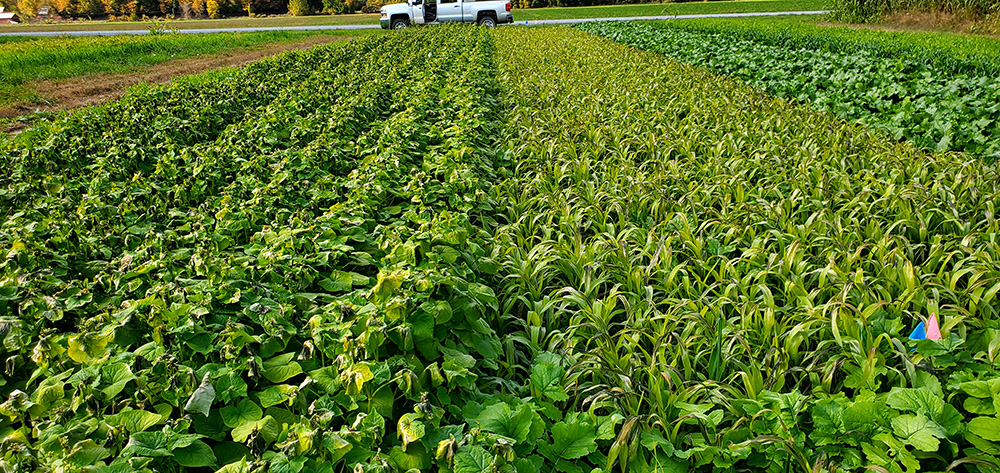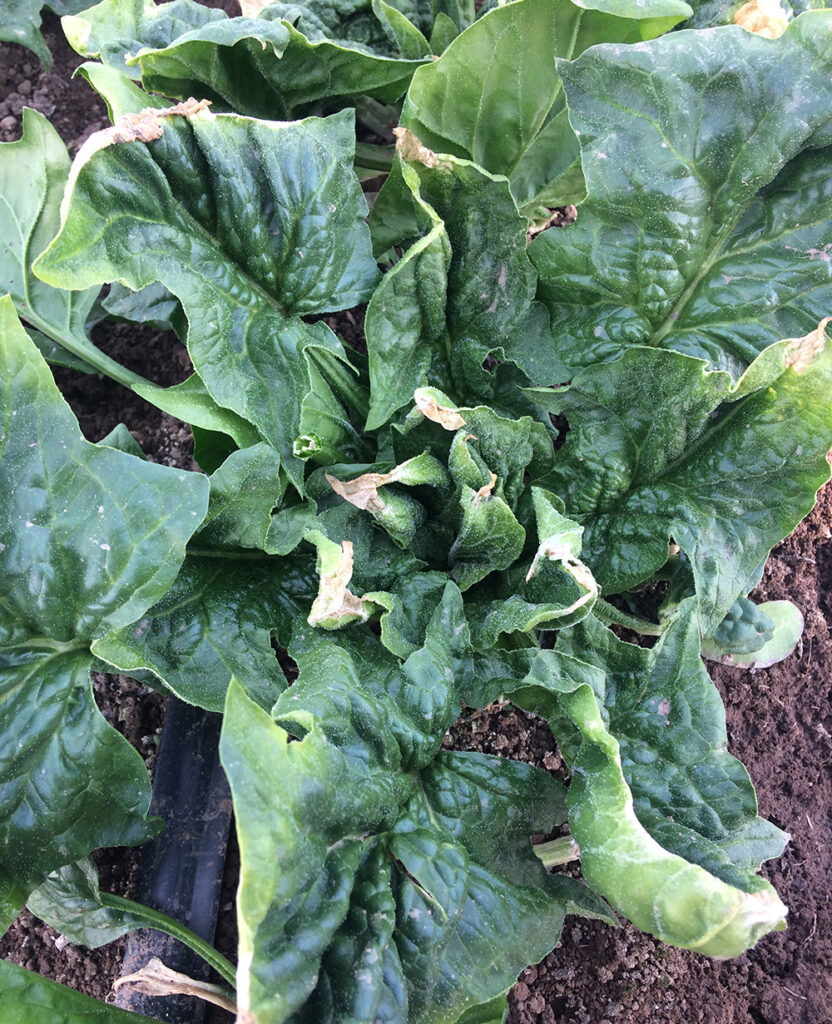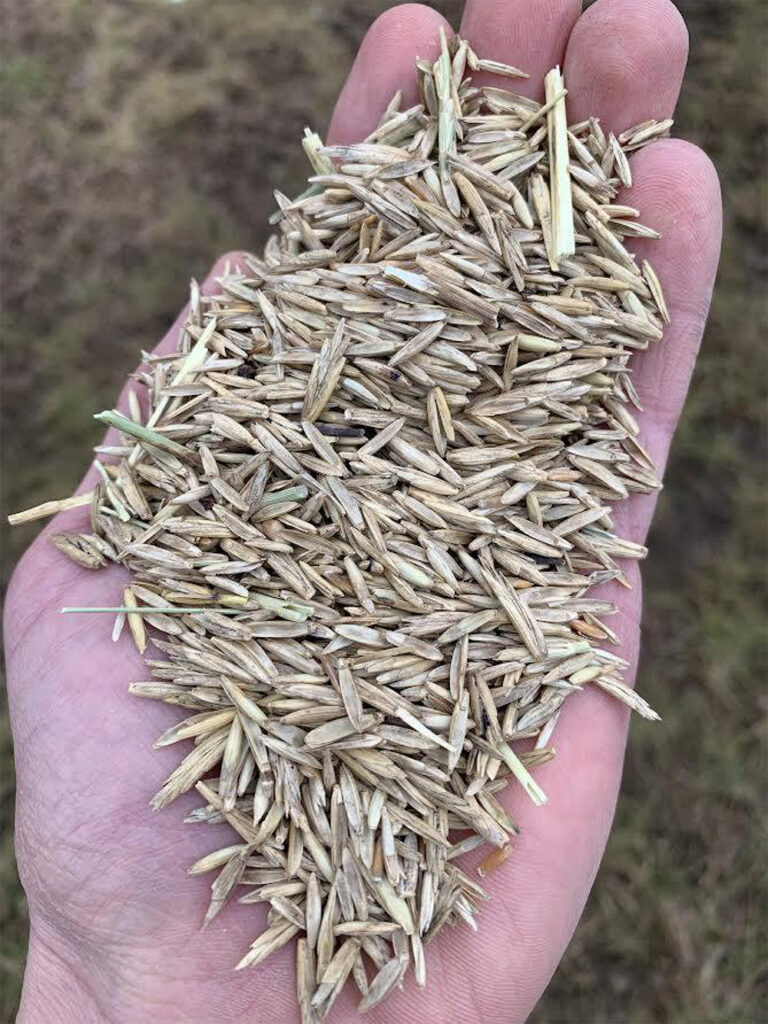Fields double as laboratories with new research trials
Leer en Español
By Jeff Arnold, Farm Manager, and the Sustainable Cropping Systems Lab team
Agronomic research at the Farm Hub serves as one of the main engines for the development and sharing out of growing practices that can help to support ecological and economic resiliency on Hudson Valley farms. In the 2023 growing season, we welcome several new research trials in collaboration with Cornell Cooperative Extension Eastern New York (CCE ENY) and the Cornell Sustainable Cropping Systems Lab. We will also be continuing the Small Grains Variety Trial with Cornell University, the Greenhouse Gas Exchange Trial with CCE ENY, and the Sweet Potato Slip Production Trial with CCE ENY.
No-till Spring Wheat (in collaboration with the Cornell Sustainable Cropping Systems Lab)
Organic spring wheat requires fall or spring tillage for terminating winter annuals and preparing the seedbed. Fall tillage leaves the soil uncovered over the winter, exposing the soil to erosion and deterioration of surface soil structure. Spring tillage is often dependent upon ideal soil conditions for frost tillage or adequate soil drying, both of which are tight work windows that can adversely affect critical early planting of spring small grains. By shifting tillage and labor to late summer (from late fall or early spring) and establishing a winter killing cover crop, winter annual weeds can be suppressed, and the seedbed may be sufficient for no-till frost drilling of the spring wheat.
Cover crop-based organic no-till crop production research has focused on no-till planting soybean and dry bean into rolled-crimped cereal rye and no-till planting corn into rolled-crimped hairy vetch. Little research has explored the potential to no-till plant small grains into cover crop residue, despite the critical role that small grains play in organic cropping systems.
We hypothesize that spring wheat yield and quality will vary by treatment and be greatest in cover crop treatments with legume and brassica cover crops. Spring wheat will be no-till planted into plots in March with a no-till grain drill. Crop and weed biomass samples will be collected at the soft dough stage in July 2023. Grain yield will be sampled when wheat grain dries to 20% moisture, and samples will be collected and analyzed for test weight and other quality parameters including protein, falling number, and the mycotoxin deoxynivalenol (DON), which is caused by Fusarium head blight.

Inter-row Mower with Cornell Sustainable Cropping Systems Lab
The Inter-Row Mowing (IRM) experiment will be conducted to evaluate the effects of inter-row mowing at different intervals throughout the growing season in organic no-till planted dry bean production.
Organic no-till dry bean production holds promise for reducing tillage as well as fuel and labor costs associated with repeated cultivation in tillage-based organic production systems. Additionally, mulch from rolled-crimped cover crops can preserve soil moisture in dry summers and reduce erosion and other negative soil and water health impacts of extreme weather. However, weeds that break through the mulch can be a substantial obstacle, and methods to reduce the risk of failure in these systems are needed to improve farmer adoption.
The inter-row mower is front mounted and driven by hydraulics that propel swing blades mounted to a rotary disc inside an enclosure to protect the crop. Results show that the inter-row mower can effectively control weeds that emerge between 30-inch crop rows. In organic no-till planted soybean in 2022, Cornell researchers observed a 60% reduction in weed biomass with inter-row mowing compared to standard weed suppression from rolled crimped cover crops.

High Tunnel Tomato Potassium Fertility Study with CCE ENY
Tomatoes are one of the most widely grown high tunnel crops in the northeast, and with good nutrient management, can be a very profitable crop. Potassium is a macronutrient that plays a key role in tomato fruit development and ripening. When potassium is deficient, tomatoes may develop green shoulders and a hard, white core. In high tunnel systems, where optimal yield and quality is required to justify the high-cost and labor-intensive growing systems, potassium management is especially important and can also be especially challenging.
A steady supply of potassium is necessary throughout a tomato plant’s fruiting period. In high tunnels, environmental conditions during peak summer ripening periods may inhibit nutrient uptake and utilization. Growers will often use foliar testing to determine plant nutrient levels and make nutrient adjustments to the soil through irrigation water. However, even when adequate potassium levels are present in the soil, high temperatures in high tunnel environments can inhibit potassium uptake through the root system. The high tunnel growing season is also typically several months longer than the field season, resulting in higher overall potassium requirements and potentially excessive costs if fertilizer is applied but not utilized by the plant.
This trial will evaluate the effect of several different organic potassium sources and application rates, both pre-plant and foliar applied, at various intervals throughout the season, and their effect on tomato fruit quality and marketable yield. Using foliar tissue testing, it will evaluate the tomato plants’ potassium utilization so that growers may direct potassium applications in the most cost-effective and efficient manner. It will also look at the effect of different mulches on soil temperature and plant potassium levels.

High Tunnel Leafy Green Calcium Deficiency Prevention with CCE ENY
As the demand for seasonal local produce continues to increase, many regional vegetable growers have begun to produce greens in unheated high tunnels during the winter months. In these greens production systems where cold soil is prevalent, calcium uptake is often inadequate, even if optimal levels are present in the soil. Calcium is an essential plant nutrient that, when deficient, can cause tip burn and unmarketable leaves on certain leafy greens.
This trial will look at several programs to supplement calcium to the plant via foliar spray applications with organic calcium products. Periodic soil and leaf tissue samples will be collected throughout the winter growing season from October through March. A report will include marketable yields and calcium levels of leaf tissue for each treatment over the season.
Kernza Seeding Rate Trial with Cornell Sustainable Cropping Systems Lab
Kernza is the first perennial grain crop to be developed and commercialized. Although Kernza can be planted once and harvested for grain for several years, grain yields are lower than annual grain crops such as wheat. However, consumer demand for Kernza currently exceeds supply, especially for organic Kernza. Most research on Kernza has focused on variety development, identifying best management practices, and quantifying ecosystems services from Kernza. As with other crops, region-specific information is needed about Kernza performance to assist farmers with management decisions.

Weed management in Kernza during the establishment year (i.e., before the first grain harvest) is a major constraint, especially in organic production. Similar to other perennial crops, Kernza grows slowly and is susceptible to weed-crop competition before it is fully established. Previous research has shown limited success with mechanical weed management (tine weeding and mowing) and intercropping with red clover.
One cultural weed management practice that has not been explored yet is increasing the seeding rate of Kernza. Increasing seeding rates is a common cultural weed management practice that can increase the relative competitive ability of crops. The current standard seeding rate that is recommended for Kernza production is 15 lbs/acre, but this recommendation was developed under conventional management conditions in an arid environment. Previous research in Minnesota on narrow vs. wide row in Kernza spacing showed that shading from narrow row spacing reduced weed abundance.
The Kernza seeding rate experiment will look at several different seeding rates from 5 to 45 pounds per acre, evaluate weed populations, compare yields, and make a seeding rate recommendation that can suppress weeds the most effectively.
